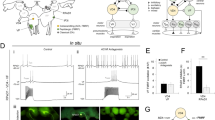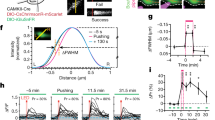Abstract
Synaptic transmission between mechanosensory and motor neurons of the gill withdrawal reflex in Aplysia can undergo both short-term1,2 and long-term3,4 modulation. One form of short-term synaptic depression lasting minutes can be evoked by the peptide Phe-Met-Arg-Phe-amide (FMRFamide)5–8, and is mediated by the lipoxygenase pathway of arachidonic acid7. We report here using cell culture9, that the same monosynaptic sensory-to-motor component of the gill withdrawal reflex can also undergo long-term synaptic depression lasting 24 h after five applications of FMRFamide over a 2-h period. The long-term depression evoked by FMRFamide is transmitter-specific. Dopamine or low-frequency stimulation of sensory neurons, which also produce short-lasting synaptic depression in vivo1,5, failed to evoke a long-term change. As is the case for long-term presynaptic facilitation of this connection with serotonin10, the long-term depression, but not the short-term, can be blocked when applications of FMRFamide are given in the presence of anisomycin, a reversible inhibitor of protein synthesis. Thus, heterosynaptic depression parallels heterosynaptic facilitation in having a long-term as well as a short-term form, and in both cases the long-term modulation requires the synthesis of gene products not essential for the short-term changes.
This is a preview of subscription content, access via your institution
Access options
Subscribe to this journal
Receive 51 print issues and online access
$199.00 per year
only $3.90 per issue
Buy this article
- Purchase on Springer Link
- Instant access to full article PDF
Prices may be subject to local taxes which are calculated during checkout
Similar content being viewed by others
References
Castellucci, V. F., Pinsker, H., Kupfermann, I. & Kandel, E. R. Science 167, 1745–1748 (1970).
Castellucci, V. F. & Kandel, E. R. Proc. natn. Acad. Sci. U.S.A. 71, 5004–5008 (1974).
Castellucci, V. F., Carew, T. J. & Kandel, E. R. Science 202, 1306–1308 (1978).
Frost, W. N., Castellucci, V. F., Hawkins, R. D. & Kandel, E. R. Proc. natn. Acad. Sci. U.S.A. 82, 9266–9270 (1985).
Abrams, T. W., Castellucci, V. F., Camardo, J. S., Kandel, E. R. & Lloyd, P. E. Proc. natn. Acad. Sci. U.S.A. 81, 7956–7960 (1984).
Belardetti, F., Kandel, E. R. & Siegelbaum, S. A. Nature 325, 153–156 (1987).
Piomelli, D. et al. Nature 328, 38–43 (1987).
Mackey, S. L. et al. Proc. natn. Acad. Sci. U.S.A 84, 8730–8734 (1987).
Rayport, S. G. & Schacher, S. J. Neurosci. 6, 759–763 (1986).
Montarolo, P. G. et al. Science 234, 1249–1254 (1986).
Brunelli, M., Castellucci, V. F. & Kandel, E. R. Science 194, 1178–1181 (1976).
Mackey, S. L., Hawkins, R. D. & Kandel, E. R. Soc. Neurosci. Abstr. 12, 1340 (1986).
Dale, N., Schacher, S. & Kandel, E. R. Science 239, 282–285 (1988).
Montarolo, P. G., Kandel, E. R. & Schacher, S. Soc. Neurosci. Abstr. 13, 391 (1987).
Schacher, S., Castellucci, V. F. & Kandel, E. R. Science (in the press).
Kandel, E. R. & Schwartz, J. H. Science 218, 433–443 (1982).
Ocorr, K. A., Tabata, M. & Byrne, J. Brain Res. 371, 190–192 (1986).
Carew, T. J. & Kandel, E. R. Science 182, 1158–1160 (1973).
Byrne, J., Castellucci, V. F., Carew, T. J. & Kandel, E. R. J. Neurophysiol. 41, 402–417 (1978).
Goldberg, J. I. & Lukowiak, K. J. Neurobiol. 15, 395–411 (1984).
Lockery, S. R. & Kristan, W. B. Soc. Neurosci. Abstr. 13, 388 (1987).
Leaton, R. N. & Supple, W. J. Science 232, 513–515 (1986).
Jordan, W. P. & Leaton, R. N. J. comp. physiol. Psychol. 96, 170–183 (1982).
Author information
Authors and Affiliations
Rights and permissions
About this article
Cite this article
Montarolo, P., Kandel, E. & Schacher, S. Long-term heterosynaptic inhibition in Aplysia. Nature 333, 171–174 (1988). https://doi.org/10.1038/333171a0
Received:
Accepted:
Issue Date:
DOI: https://doi.org/10.1038/333171a0
This article is cited by
-
The vertical lobe of cephalopods: an attractive brain structure for understanding the evolution of advanced learning and memory systems
Journal of Comparative Physiology A (2015)
-
Neuroplasticity Mediated by Altered Gene Expression
Neuropsychopharmacology (2008)
-
Nonassociative learning as gated neural integrator and differentiator in stimulus-response pathways
Behavioral and Brain Functions (2006)
-
Is Heterosynaptic modulation essential for stabilizing hebbian plasiticity and memory
Nature Reviews Neuroscience (2000)
-
Modulation of ion currents and regulation of transmitter release in short-term synaptic plasticity: The rise and fall of the action potential
Invertebrate Neuroscience (1995)
Comments
By submitting a comment you agree to abide by our Terms and Community Guidelines. If you find something abusive or that does not comply with our terms or guidelines please flag it as inappropriate.



